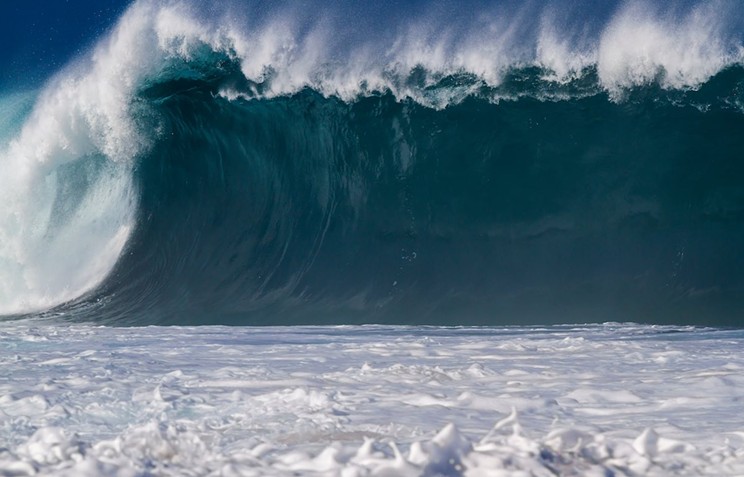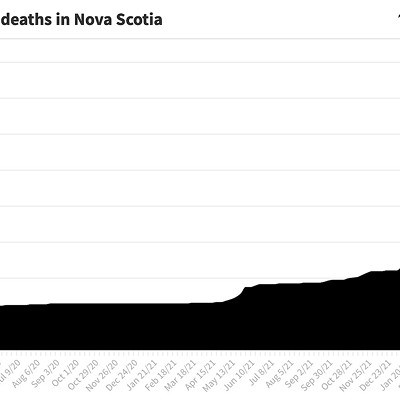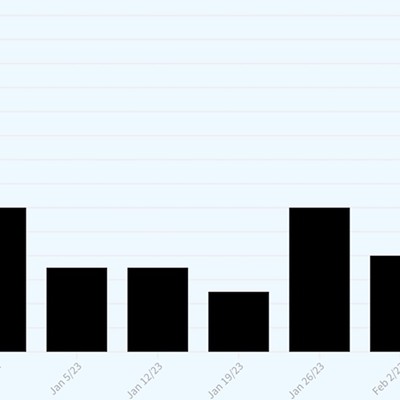Does everyone you know have COVID? It certainly feels like everyone has it. And given the latest pandemic numbers released by the province yesterday, there's good reason for that feeling. During the entire pandemic, now into its third year, Nova Scotia has never had as many new cases reported as right now.
Because the government recently switched to putting out a weekly report instead of doing daily updates, the newest numbers don't mesh perfectly with the data the province had been reporting daily since March 2020. A cynical person might say that’s part of premier Tim Houston’s plan to change the COVID conversation, putting out weekly data—consider this apples—disconnected from the daily numbers—oranges—to make pandemic-wide comparisons impossible.
A practical person would spend countless hours toiling in their basement lab to convert years of daily data into weekly data, allowing an apples-to-apples comparison. And we are nothing at The Coast if not practical.
Here is the graph showing the total number of cases Nova Scotia has reported every week since November 2021, just before the omicron wave of infections started. You’ll notice that for two weeks in a row at the end of December and in early January, there were a lot of cases, nearly 5,700 each week. But last week there were more. Yesterday's report says there were 6,991 positive PCR tests performed at the lab.
To get a sense for how omicron compares to the rest of the pandemic, we made the following brand-new graph. It shows how many cases have been reported every day, on average, each Thursday in the entire pandemic. The Thursday daily average is the best we can do to make apples out of all the data Nova Scotia is reporting, including the weekly data.
The average is calculated by adding up all the cases reported on the seven days leading up to and including each Thursday, and dividing that total by seven to get the daily average as reported on the Thursday. Yesterday, for example, the report said there were 6,991 cases over the past week, which works out to 999 cases per day on average.
Before yesterday, the highest 7-day rolling average on a Thursday was 877 cases per day, on January 6, 2022. At the far left edge of the graph you're find that at the peak of the first wave in Nova Scotia, when the entire province was locked down tight, the highest average daily infection count was 35 per day cases on April 23, 2020.
New cases aren’t the only thing that determines COVID risk; dying from the disease is the ultimate risk, so let’s call deaths the ultimate indicator. And the short answer is that people are still dying from the disease at this point in the omicron wave, which has been far and away the deadliest period of the pandemic in Nova Scotia.
Here is the graph showing the total death toll, with its precipitous recent increase. What that graph doesn't show well is the rise and fall in the number of deaths being reported each week, such as the eight deaths yesterday.
This is that graph, which The Coast created by adding up all the deaths reported each week over the course of the daily reports, to create a weekly total that can be compared to the weekly total the province is now issuing on Thursday. And what this graph shows is that the number of people dying from COVID has been dropping each of the last three weeks.
Eight people dying in a week will never feel like something to celebrate, but the trend of deaths declining is wonderful to see. The only caveat is that the death rate is a trailing or lagging indicator: if someone is going to die of COVID, it usually happens some time after they've been infected.
So the steep rise in new infections we’re getting right now could lead to a rise in deaths in a few weeks. And the decline in deaths the province has enjoyed over the last month could relate to the decline in infections that happened in February before the current surge. Or maybe human diligence and experience has rendered COVID less deadly than it has been, thanks to some combination of more people getting third doses of vaccine, hospitals getting better at treating cases and the most vulnerable Nova Scotia's maintaining protections like the mask mandate remaining in healthcare situations.
Is it too early to tell? Premier Houston apparently doesn't think so, and all we can do is hope he's right and that deaths keep declining even if new infections keep going up.
Another factor in deaths is hospitalizations. It's a reasonable assumption that if someone who is infected with COVID starts to develop a particularly severe case, with serious symptoms, they will go to the hospital for treatment. From the hospital, most people recover and go home, but some people die. The number of people in hospital is therefore a limit on potential deaths. When there are a more people hospitalized with COVID, in other words, there are more people who might end up dying. (Also, more COVID hospitalizations means more stress on the health system, which potentially affects the treatment all patients receive, but the weekly report from the province doesn't touch this.)
That's a lot of words to say what feels pretty obvious: It's bad when hospitalizations go up, and good when they fall. And they are going up now.
Here's the graph, showing the total number of COVID patients reported as being in hospital, every Thursday since the beginning of 2022, when the province first began reporting hospitalization data.
Like deaths, hospitalizations are a lagging indicator—there's typically some time between a person getting diagnosed with the disease, and developing symptoms major enough to require hospitalization. But unlike deaths, which have been falling in recent weeks, hospitalizations have only been going up. A good-news spin is the rise in hospitalizations hints that the death rate really is fundamentally dropping, because it’s managing to fall despite hospitalizations increasing. Also, even though hospitalizations are clearly on the rise, currently they are still below the peak of 97 patients on Feb 3, 2022 (70 of them with two or three shots of vaccine, the other 27 with either one or zero shots).
Let's not sugarcoat things too much here. In its latest report, Nova Scotia announced that eight people died of COVID, which is eight more people than anybody in the province should be comfortable with. Hospitalizations are clearly on the rise, which is never a good thing. And the province is reporting the most new COVID infections that it ever has, in this omicron wave or any other wave dating back to March, 2020. There will come a time when the worst of the pandemic is behind us, but this doesn't feel like it.

























